Lawsuits
The Arctic Venus
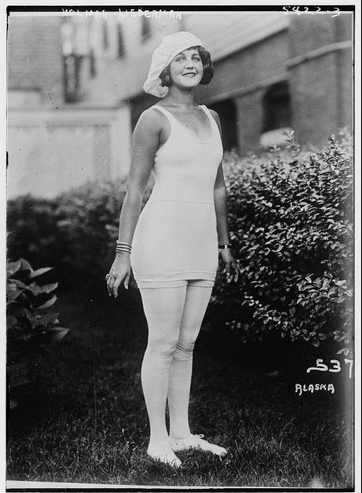
Helmar Leiderman was the first Miss Alaska. Not really one of of our "oddball beauty titles." Except that when she was disqualified on a technicality during the Miss America contest, she sued and was later arrested.
Article source: The San Francisco Examiner (San Francisco, California) 01 Nov 1925, Sun Page 140
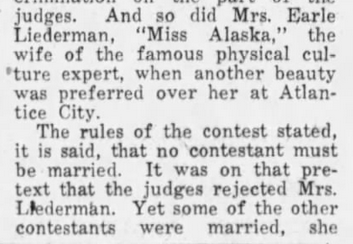
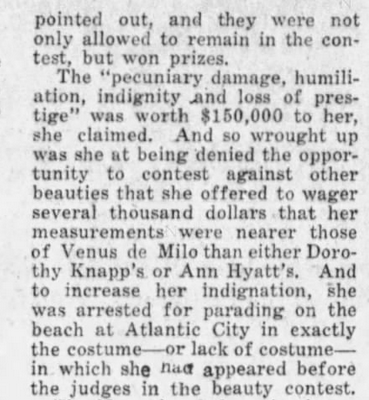
Posted By: Paul - Fri Oct 08, 2021 -
Comments (0)
Category: Awards, Prizes, Competitions and Contests, Beauty, Ugliness and Other Aesthetic Issues, Lawsuits, 1920s
Unauthorized Dwellings 17
Are the entire populations of San Francisco and Sacramento squatters? One person, John Sutter, believed so.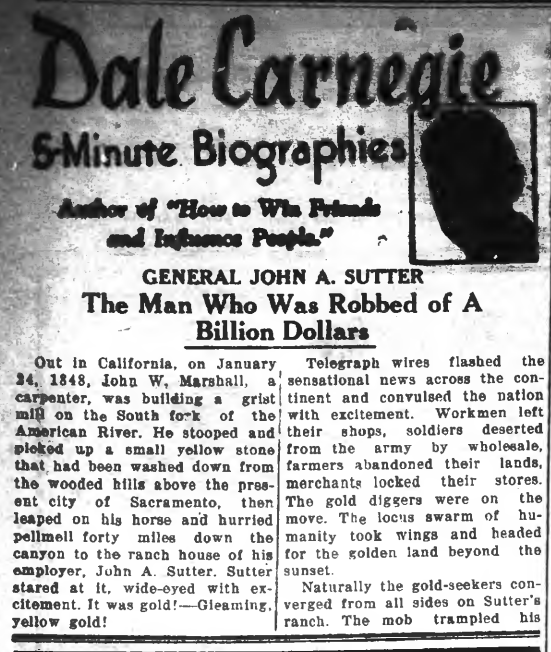
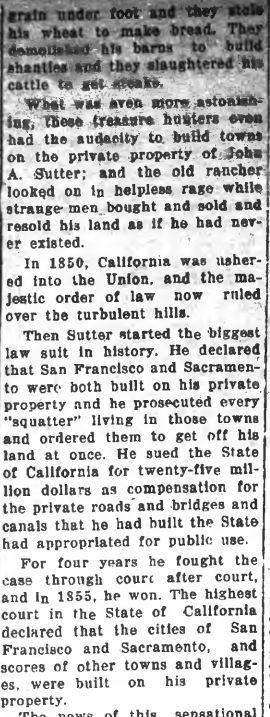
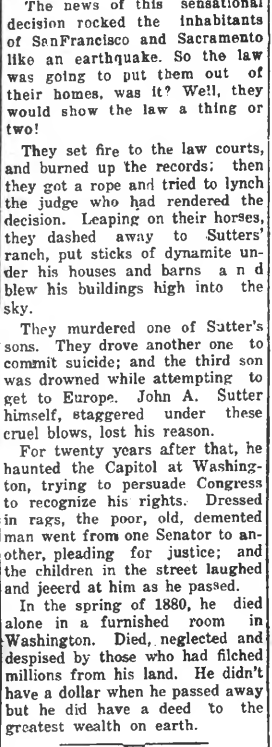
Article source.
Posted By: Paul - Wed Jun 30, 2021 -
Comments (2)
Category: Lawsuits, Unauthorized Dwellings, North America, Nineteenth Century
Stripper Unsexy?
Source: Nanaimo Daily News (Nanaimo, British Columbia, Canada)14 Sep 1957, Sat Page 2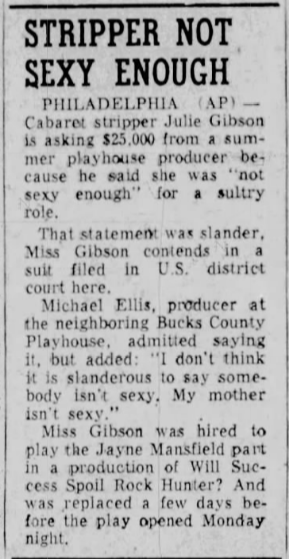

Posted By: Paul - Tue May 25, 2021 -
Comments (2)
Category: Theater and Stage, Lawsuits, Sex Symbols, 1950s
Eviction caused bad breath, dandruff
1979: After being evicted from the townhouse he was renting, R.L. Ussery filed a lawsuit against his former landlord seeking $11,000 in compensation. Ussery claimed that the eviction had caused him and his family to suffer from "colds, nausea, upset stomach, diarrhea dysentery, loss of hair, sweating palms, the need to void, the inability to void, nightmares, insomnia, dandruff, bad breath, dirty fingernails, odoriferous body odors, especially of the feet, palm itching, the blues and the blahs, nervousness, dry heaves and crying spells."I don't know what the result of the lawsuit was, but I think it's highly unlikely that Ussery won.

Tampa Tribune - Aug 24, 1979
Posted By: Alex - Mon May 17, 2021 -
Comments (1)
Category: Lawsuits, 1970s
Suing the Devil
1971: Inmate Gerald Mayo made legal history by trying to sue "Satan and his staff" for violating his rights by "placing irresistible temptation in his path." The judge dismissed the case because Satan lived outside the court's jurisdiction, and federal marshals were unable to bring him to the court.
Pomona Progress Bulletin - Dec 9, 1971
Suing the Devil was also the theme of a 2010 film starring Malcolm McDowell as Satan.
Posted By: Alex - Sat Feb 20, 2021 -
Comments (3)
Category: Religion, Lawsuits
The Sins of the Children
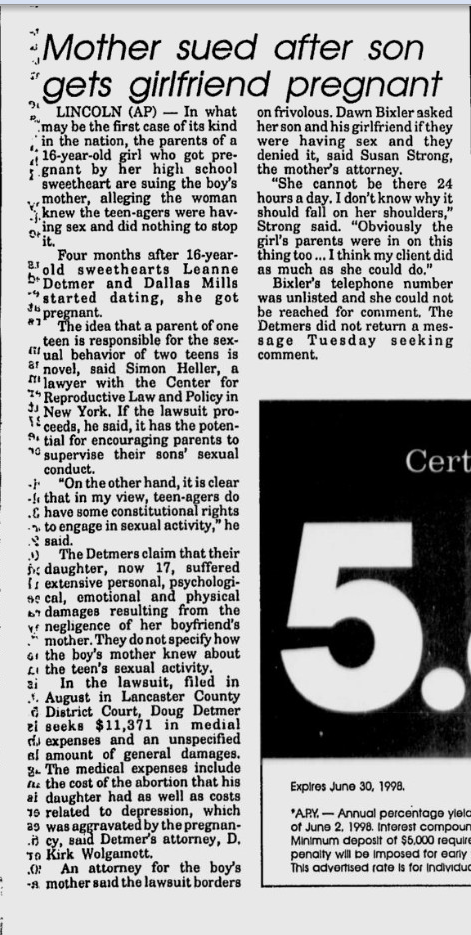
Article source.
WASHINGTON POST coverage here.
Here is the official write-up of the case and its outcome.
Posted By: Paul - Wed Jan 13, 2021 -
Comments (1)
Category: Lawsuits, Parents, Teenagers, 1990s, Pregnancy
Santa Claus sues Santa Claus
The dispute began in 1935 between two toy and candy companies, both based in the town of Santa Claus, Indiana. On one side there was Santa Claus, Inc. On the other side was Santa Claus of Santa Claus, Inc. The former alleged that the latter shouldn't have chosen such a similar name.In response, Santa Claus of Santa Claus, Inc. charged that its rival illegally put up a 25-foot, 20-ton Santa statue on land leased to Santa Claus of Santa Claus, Inc.
The lawsuit, Santa Claus, Inc. v. Santa Claus of Santa Claus, Inc., eventually made its way up to the Indiana Supreme Court.
As far as I can tell, Santa Claus of Santa Claus, Inc. won the fight. But either way you look at it, Santa Claus won.

Muncie Evening Press - Dec 30, 1935
Posted By: Alex - Fri Dec 25, 2020 -
Comments (0)
Category: Lawsuits, 1930s, Christmas
“Pregnancy forces granny to quit work at age 101”
In October 1990, the Sun ran a story about a 101-year old woman who supposedly had to quit her job as a newspaper carrier because she got pregnant after being seduced by a reclusive millionaire on her route. The story, of course, was totally false. However, the Sun also ran a picture with the article of a real woman, 96-year-old Nellie Mitchell of Arkansas.Mitchell sued, charging invasion of privacy (she had never given them permission to use her photo) and emotional distress, because she now had to endure people asking her when the baby was due. During the trial, the editor of the Sun explained that they had needed a picture to go along with the fake story, and had found in their archive a photo of Mitchell taken in 1986. They had used it, assuming she must have been dead by then. And dead people can't sue for damages.
Mitchell won and was awarded $150,000 in compensatory damages and $850,000 in punitive damages.

Baxter Bulletin - Oct 19, 1993
Posted By: Alex - Sun Dec 20, 2020 -
Comments (7)
Category: Elderly and Seniors, Journalism, Lawsuits, 1990s
Paul Kim v. IRS
2013: Paul Chulhie Kim filed suit against the IRS for $20 million in damages, alleging that he had been waiting 24 years for them to get back to him about his job application. On account of this long wait, he said, he had suffered various health problems including "starvation, heart attacks, heart failure, kidney failure, liver failure, pneumonia, seizures, cancer [and] mental illness." It seems that he never bothered to try to get a different job. He wanted the $20 million to "restore [his] trust in the American people and restore confidence in [his] natural United States citizenship."The judge noted that Kim appeared to be hinting that some kind of employment discrimination had occurred, without stating this explicitly. But even so, because Kim had waited so long to file his case, the statute of limitations had long since expired. So the judge dismissed the case.
Kim appealed the decision, but the appeals court affirmed the District Court's decision.
More info: Penn Record, law.villanova.edu

Posted By: Alex - Fri Dec 04, 2020 -
Comments (1)
Category: Jobs and Occupations, Lawsuits
Court refuses one-cent suit
October 1939: The Supreme Court refused to hear the case of C. Leon De Aryan, thereby ending his legal campaign to recover the one cent of sales tax he believed he had been incorrectly charged.Actually, it was worse than that. The actual amount of the excess charge in question was closer to one-half a cent. De Aryan had bought 15 cents worth of cardboard, and had been charged one cent of sales tax on this purchase. He noted that the tax was three percent. Therefore, he should only have been charged approximately one-half cent of tax, but the retailer rounded up.
I'm guessing De Aryan spent a lot more than one cent in court costs.

San Pedro News-Pilot - Oct 9, 1939
This recalls the 1979 case of Frank Makara who felt he had been overcharged $1.95 at the gas station and took his case all the way to the Supreme Court — which then refused to hear it, as it did with De Aryan's case.
Posted By: Alex - Wed Nov 04, 2020 -
Comments (5)
Category: Lawsuits, 1930s

| Who We Are |
|---|
| Alex Boese Alex is the creator and curator of the Museum of Hoaxes. He's also the author of various weird, non-fiction, science-themed books such as Elephants on Acid and Psychedelic Apes. Paul Di Filippo Paul has been paid to put weird ideas into fictional form for over thirty years, in his career as a noted science fiction writer. He has recently begun blogging on many curious topics with three fellow writers at The Inferior 4+1. Contact Us |




